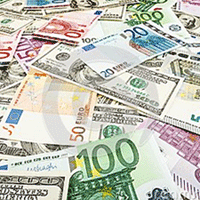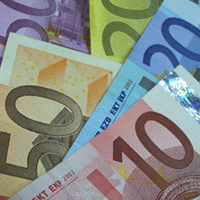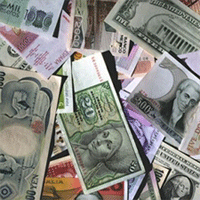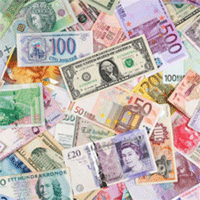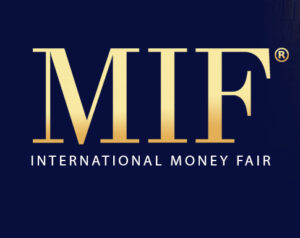Banknotes
During the Paper Money Fair Maastricht / Banknote Fair Maastricht many banknote dealers will be present with a great variety of world banknotes.
What are banknotes?
A banknote (often known as a bill, paper money, or simply a note) is a type of negotiable instrument known as a promissory note, made by a bank, payable to the bearer on demand. Banknotes were originally issued by commercial banks, who were legally required to redeem the notes for legal tender (usually gold or silver coin) when presented to the chief cashier of the originating bank. These commercial banknotes only traded at face value in the market served by the issuing bank. Commercial banknotes have primarily been replaced by national banknotes issued by central banks.
National banknotes are generally legal tender, meaning that medium of payment is allowed by law or recognized by a legal system to be valid for meeting a financial obligation. Historically, banks sought to ensure that they could always pay customers in coins when they presented banknotes for payment. This practice of “backing” notes with something of substance is the basis for the history of central banks backing their currencies in gold or silver. Today, most national currencies have no backing in precious metals or commodities and have value only by fiat. With the exception of non-circulating high-value or precious metal issues, coins are used for lower valued monetary units, while banknotes are used for higher values.
The idea of using a durable light-weight substance as evidence of a promise to pay a bearer on demand originated in China during the Han Dynasty in 118 BC, and was made of leather. The first known banknote was first developed in China during the Tang and Song dynasties, starting in the 7th century. Its roots were in merchant receipts of deposit during the Tang Dynasty (618–907), as merchants and wholesalers desired to avoid the heavy bulk of copper coinage in large commercial transactions. During the Yuan Dynasty, banknotes were adopted by the Mongol Empire. In Europe, the concept of banknotes was first introduced during the 13th century by travelers such as Marco Polo, with European banknotes appearing in 1661 in Sweden.
Counterfeiting, the forgery of banknotes, is an inherent challenge in issuing currency. It is countered by anticounterfeiting measures in the printing of banknotes. Fighting the counterfeiting of banknotes and cheques has been a principal driver of security printing methods development in recent centuries.
Banknotes, the History
Paper currency first developed in Tang Dynasty China during the 7th century, although true paper money did not appear until the 11th century, during the Song Dynasty. The usage of paper currency later spread throughout the Mongol Empire. European explorers like Marco Polo introduced the concept in Europe during the 13th century. Napoleon issued paper banknotes in the early 1800s. Cash paper money originated as receipts for value held on account “value received”, and should not be conflated with promissory “sight bills” which were issued with a promise to convert at a later date.
The perception of banknotes as money has evolved over time. Originally, money was based on precious metals. Banknotes were seen by some as an I.O.U. or promissory note: a promise to pay someone in precious metal on presentation (see representative money), but were readily accepted – for convenience and security – in the City of London for example from the late 1600s onwards. With the removal of precious metals from the monetary system, banknotes evolved into pure fiat money.
Notes or bills were often referred to in 18th century novels and were often a key part of the plot such as a “note drawn by Lord X for £100 which becomes due in 3 months’ time”.
Banknotes, who issues the banknotes?
Generally, a central bank or treasury is solely responsible within a state or currency union for the issue of banknotes. However, this is not always the case, and historically the paper currency of countries was often handled entirely by private banks. Thus, many different banks or institutions may have issued banknotes in a given country. Commercial banks in the United States had legally issued banknotes before there was a national currency; however, these became subject to government authorization from 1863 to 1932. In the last of these series, the issuing bank would stamp its name and promise to pay, along with the signatures of its president and cashier on a preprinted note. By this time, the notes were standardized in appearance and not too different from Federal Reserve Notes.
In a small number of countries, private banknote issue continues to this day. For example, by virtue of the complex constitutional setup in the United Kingdom, certain commercial banks in two of the state’s four constituent countries (Scotland and Northern Ireland) continue to print their own banknotes for domestic circulation, even though they are not fiat money or declared in law as legal tender anywhere. The UK’s central bank, the Bank of England, prints notes which are legal tender in England and Wales; these notes are also usable as money (but not legal tender) in the rest of the UK (see Banknotes of the pound sterling).
In the two Special Administrative Regions of the People’s Republic of China, arrangements are similar to those in the UK; in Hong Kong, three commercial banks are licensed to issue Hong Kong dollar notes,[33] and in Macau, banknotes of the Macanese pataca are issued by two different commercial banks. In Luxembourg, the Banque Internationale à Luxembourg was entitled to issue its own Luxembourgish franc notes until the introduction of the Euro in 1999.
As well as commercial issuers, other organizations may have note-issuing powers; for example, until 2002 the Singapore dollar was issued by the Board of Commissioners of Currency Singapore, a government agency which was later taken over by the Monetary Authority of Singapore.
